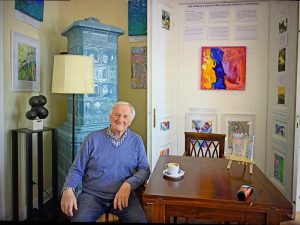
From the other side of the curtain
There are different motives that motivate artists to create. Some artists create to capture the harmony and beauty of the world that surrounds them, others to point out its failures. Some artists create to manifest themselves and their inner world, others do so to manifest the collective. Some create out of necessity. Others make creations for the sake of it. But most focus on the result of their work, ignoring the very process of creation as an autonomous value. Although he began to pursue painting spontaneously, in the second phase of his life’s journey, Vjeko Martinko intuitively sensed the value of the creative process. He sensed a meditative, transcendent aspect of creation that separates us from ourselves and the world to which we belong, and takes us from the other side of the curtain, into the realm of the subconscious, the oniric and the spiritual. He indulged in painting as the child indulges in play, without hesitation and too much thought, an open heart and mind. His painting became the meeting point of the material and spiritual worlds, and his body was a medium for mediating ideas from the realm of the invisible. By applying paint directly to the canvas with his own hands, Vjeko realized the immediacy of the performance, and with his creative automatism he ensured unhindered communication with others. Through the process of creation he repeatedly undergoes catharsis, exhausts himself to regenerate, forgets to recall, releases to receive.
When it comes to Vjekino’s painting, we must inevitably remember the stylistic directions of the mid-20th century, enformel and abstract expressionism as painting a gesture that escapes the control of reason. But if the painter’s gesture is governed not by reason but by psychic automatism, what actually constitutes the content of Eternal Painting? His summary is refined from the associativity of the world in question and is reduced to abstract values that, while invisible, govern our existence. It is an energy manifested in the powerful dynamics of his movements and impasto spreads, and these are emotions that are manifested in the lush color. Veca’s painting is characterized by a sincerity that is read from the original idea to the last move of the performance. His painting does not communicate meanings but experiences, thus communicating directly, without the barriers of age, gender or education. Each of his works reveals a fraction of collectivity and reminds us that in everything we do and feel we are not alone. It reminds us of the spirituality we have lost, and points to the spiritual aspect as crucial in achieving the mental health and self-actualization of each individual.
Vana Gogić, Rijeka, Bachelor of Arts, Curator, Ethnologist and Cultural Anthropologist, Author of various exhibitions


































































